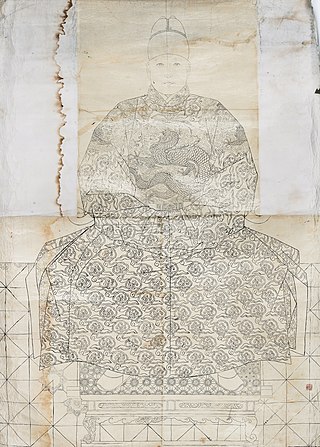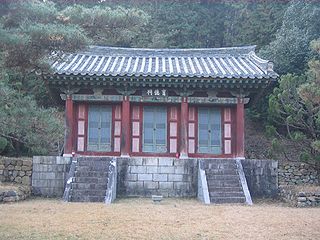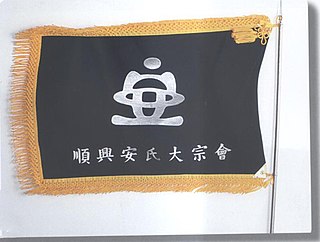
Sejong of Joseon, personal name Yi Do, commonly known as Sejong the Great, was the fourth ruler of the Joseon dynasty of Korea and the inventor of Hangul, the native alphabet of the Korean language. Today, he is regarded as one of the greatest leaders in Korean history.

Lee, I, or Yi is the second-most-common surname in Korea, behind Kim (김). Historically, 李 was officially written as Ni in Korea. The spelling officially changed to I in 1933 when the initial sound rule was established. In North Korea, it is romanized as Ri because there is no distinction between the alveolar liquids /l/ and /r/ in modern Korean. As of the South Korean census of 2015, there were 7,306,828 people by this name in South Korea or 14.7% of the population.
Seong Sam-mun was a scholar-official of early Joseon who rose to prominence in the court of King Sejong the Great. He was executed after being implicated in a plot to dethrone King Sejo and restore his predecessor King Danjong, and is known as one of the sayuksin with reference to this plot.

Sejo of Joseon, personal name Yi Yu, sometimes known as Grand Prince Suyang, was the seventh ruler of the Joseon dynasty of Korea. He was the second son of Sejong the Great and the uncle of King Danjong, against whom he led a coup d'état in 1453.
The Hall of Worthies, or Jiphyeonjeon, was a royal research institute set up by Sejong the Great of the Korean Joseon Dynasty in March 1420. Set up during the beginning of his reign, King Sejong staffed the Hall of Worthies with talented scholars and instructed them to conduct a variety of research activities to strengthen his rule and the nation. The Hall of Worthies is known for its role in compiling the Hunminjeongeum, the original treatise on Hangul.
The six martyred ministers or Sayuksin were six ministers of the Joseon Dynasty who were executed by King Sejo in 1456 for plotting to assassinate him and restore the former king Danjong to the throne.
Pak Paeng-nyeon was a scholar-official of the early Joseon Dynasty, and is known as one of the six martyred ministers. He was born to a yangban family of the Suncheon Park clan, and was the son of high minister Park Jeong-rim. He passed the lower national service examination at a royal visitation in 1434, and was later appointed to the Hall of Worthies by Sejong. In the 1440s, he participated with other members of the Hall of Worthies in the creation of the Hunminjeongeum and the creation of the Hangul alphabet. He passed the higher literary examination in 1447, and rose to vice-minister of justice under Danjong in 1454. He was an 8th cousin of Park Won-jong, the maternal uncle of Yun Im and Queen Janggyeong, the second wife of King Jungjong.
Ha Wiji (1387–1456) was a scholar-official of the early Joseon Dynasty, and is remembered as one of the six martyred ministers. He was born to a yangban family of the Jinju Ha lineage. He passed the lower national service examination in 1435 and received the top score on the higher examination in 1438. He was appointed to the Hall of Worthies by Sejong, and became the leader (gyori) of that institution in 1442. He participated in the editing of histories and other texts.
Yi Gae was a scholar-official of the Joseon Dynasty who came from the yangban family Hansan Yi clan and one of the six martyred ministers. He was the great-grandson of Goryeo period philosopher Yi Saek and third cousin of Yi San-hae.
Yu Eung-bu (?~1456) was a military official of the early Joseon Dynasty and is remembered as one of the six martyred ministers. Yu was born in Pocheon; his date of birth and lineage are not known with certainty.
Gim Jil, also often spelled Kim Chil, was a scholar-official of the early Joseon Dynasty. He is remembered today primarily for his participation in, and betrayal of, the conspiracy led by the six martyred ministers.
An, also romanized Ahn, is a Korean family name. 109 Korean clans are named 'An', but with different origins. In 2000, there were 637,786 people bearing this surname in South Korea, making it the 20th most common family name in the country, with roughly 2% of the country's population. North Korea does not release figures for surnames, but the percentage is expected to be more than in South Korea.

Kim Jong-jik, often known by his art name Jeompiljae (Korean: 점필재), was a leading Korean Neo-Confucian scholar in the early Joseon dynasty. He was born in Miryang in Gyeongsang Province, to a yangban family of the Seonsan Gim clan. He passed the jinsa literary licentiate examination in 1453 and the higher examination in 1459.
Ryu Seong-ryong, was a scholar-official of the Joseon Dynasty of Korea. He held many responsibilities including the Chief State Councillor position in 1592. He was a member of the "Eastern faction", and a follower of Yi Hwang.
Three Offices, or Samsa (삼사·三司), is a collective name for three government offices in the Joseon Dynasty that functioned as major organ of press and provided checks and balance on the king and the officials. These were Office of Inspector General (Saheonbu·사헌부), Office of Censors (Saganwon·사간원), and Office of Special Advisors (Hongmungwan·홍문관).
Kim Ja-jeom was a Korean scholar-official of the Joseon dynasty period and Ming-Qing transition. He was one of the disciples of Seong Hon and came from the Andong Kim clan.

The Westerners was a political faction that dominated Korea in the 17th century. In 1575, the Sarim split into the Easterners and Westerners. The Westerners remained the main contender of the Easterners in the Seonjo age.

The Jingbirok is a first hand account of the Imjin War written by high ranking Joseon scholar-official Ryu Seong-ryong. It is written in hanja.
Queen Jeongsun, of the Yeosan Song clan, was a posthumous name bestowed to the wife and queen consort of Yi Hong-wi, King Danjong, the 6th Joseon monarch. She was queen consort of Joseon from 1454 until her husband's abdication in 1455, after which she was honoured as Queen Dowager Uideok (의덕왕대비) until her deposition in 1457.

The Sunheung Ahn clan is a clan connected with the town of Sunheung, South Korea, and was well known during the Goryeo Dynasty and in the early Joseon Dynasty for its so-called "blue-blood" status.